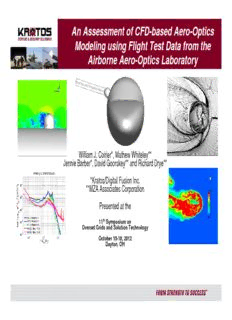
An Assessment of CFD-based Aero-Optics Modeling using Flight Test Data from the Airborne Aero ... PDF
Preview An Assessment of CFD-based Aero-Optics Modeling using Flight Test Data from the Airborne Aero ...
An Assessment of CFD-based Aero-Optics Modeling using Flight Test Data from the Airborne Aero-Optics Laboratory William Coirier, Ph.D. William J. Coirier*, Mathew Whiteley** Jennie Barber*, David Goorskey** and Richard Drye** *Kratos/Digital Fusion Inc. **MZA Associates Corporation Presented at the 11th Symposium on Overset Grids and Solution Technology October 15-18, 2012 Dayton, OH Acknowledgements • This work is sponsored through a contract with Air Force Research Laboratory, Directed Energy Directorate, Starfire Optical Range (AFRL/RDS) • Contract #FA9451-11-C-0191 • Capt Doug MacDonald, 1Lt Michael Paul, Dr. Donald Wittich • Development of the CFD-AO capability sponsored by the Air Force Research Laboratory, Air Vehicles Directorate, Computational Applications Branch (AFRL/RBAT) • Technical Monitor: Dr. Scott Sherer • This work was supported in part by a grant of computer time from the DOD High Performance Computing Modernization Program at the USASMDC Simulation Center. •Colleagues/Collaborators/Coauthors at MZA Associates Corporation • Dr. Mathew Whiteley, Dr. David Goorskey, Richard Drye •Colleagues/Collaborators at Kratos/Digital Fusion • Jennie Barber, Ricky Brown Outline • Brief Description of the AAOL Program and of the CFD Modeling Goals • CFD-AO Model • CFD Model of the AAOL for this study • Summary of CFD Study To Date • Mesh and Time Refinement Study • Detailed Investigation of Modeling Effects upon Modeled Distortions • Conclusions and Discussions Airborne Aero-Optics Laboratory (AAOL) HEL-JTO Funded, AFOSR Grant Source Aircraft •• SSmmaallll--AAppeerrttuurree DDiivveerrggiinngg BBeeaamm//BBeeaaccoonn •• NNeegglliiggiibbllee AAeerroo--OOppttiicc EEffffeeccttss •• OOvveerrffiillll AAAAOOLL AAppeerrttuurree xx 22 •• 44”” CClleeaarr AAppeerrttuurree,, 1122””TTrraacckkiinngg TTuurrrreett AAOL •• SSpphheerriiccaall WWaavveeffrroonntt ““uunnaaffffeecctteedd”” bbyy TTiipp//TTiilltt aatt ssoouurrccee CFD Modeling for the AAOL • Primary Goals: Aero-Optical and Aero-Mechanical Distortion Modeling • Model the near turret aero-optical distortions and compare to measured • Model the unsteady aero-mechanical forcings on the turret, and pass these to a detailed FEM and waveTrain model • Secondary Goals: Evaluate Aero-Effects Modeling Capability • Investigate the flow fields produced by the CFD and correlate flow features to aero- optical and aero-mechanical distortions • Investigate effects of numerics (turbulence/LES models, convective discretizations and others) upon modeled aero-optical and aero-mechanical distortions • Approach: Use CFD modeled resolved density field (index of refraction) to compute Optical Path Difference, and correlate to the measured aero-optical disturbances • Correlations of wave front error statistics and flow behavior • WFE PSD: Power Spectral Density vs. frequency • WFE POD: Proper Orthogonal Decomposition mode shapes and strengths • Produce unsteady pressure forcing on turret outer mold line • Process and pass to FEM model Foci of this briefing: Compare computed and measured aero-optical distortions Evaluate discretization and DES model effects upon aero-optical distortions CFD-AO Model • Specialization/Customization of the NASA OVERFLOW CFD model specifically for aero- optics applications • CFD-AO: Developed under AFRL/RBAT funding: Dr. Scott Sherer/TPOC OVERFLOW • Very capable CFD model that has been under continuous development and improvement for 20+ years • Chimera/Overset Grid System, Finite-Difference, Sophisticated Reynolds-Averaged Navier-Stokes (RANS), Hybrid RANS/LES (Detached Eddy Simulation) Models, Massively- Parallel, Very Efficient, Wide User Base and it’s free! Highly-Resolved, Massively-Parallel, Unsteady, Detached Eddy Simulation Modeling Capability CFD-AO Model • C++ class library and accompanying pre- and post-processors designed for incorporating aero-optical related data processing into generic CFD models, specially integrated into OVERFLOW version 2.2c Beam Grids OVERFLOW Integration • Pre-compute and Store CFD-to-Lattice • Implementation of a handful of CFD-AO Interpolants “public” library API • Given a CFD grid system, beam grid is used to pre-process CFD-AO • Able to compute beam propagation on the fly using a spectral/parabolic Paraxial Beam solver • Use specializations to improve processing rates and data footprints • Wide variety of pre- and post-processing tools CFD-AO Model: Specializations • Two specializations made under this project: • In-Line Optical Path Difference Calculations and Data Storage • Point-Cloud Pressure Interpolation and Data Storage In-Line OPD Calculation Point-Cloud Pressure Interpolation • Integrate Optical Path Difference integral • Interpolate Pressure onto any collection of at specified time steps and wavelength “on points (“point cloud”) the fly” as opposed to post processing • Store interpolated pressure in NetCDF file • Output each OPD field into NetCDF file • Alleviates awkward existing methods in OVERFLOW (“FOMOCO”, “BC201”) OPD r.m.s. AAOL Turret AAOL CFD Model: Geometric Model and Grid System • CAD data supplied from AFRL • Removed wing: Turret should be far enough away as to not be influenced by wing • Extended fuselage: No aft fuselage geometry • Incorporated Turret model, allowing elevation and azimuth change Cylindrical cross section fuselage No Wing extended Turret Supplied Modeled AAOL CFD Model: CFD Grid Systems • Essentially 3 Phases of CFD modeling accomplished to date: • Mesh and time step refinement study • Initial evaluation of effect of look-back angle • Investigation of numerics impact upon modeled aero-optical distortions • Initial phase of work focused upon (Az,El)=(128o,69o) for three flight conditions: • M=0.4, h=5 km. • M=0.5, h=5 km. • M=0.61, h=8 km. • All computations made at AOA=3 degrees, and Azimuth measured relative to aircraft axis • Inspection of flow field, WFE PSD, shear layer structure etc. led us to devise a finer grid system with more resolution made over the turret aperture •Initial grid system contains 26x106 grid points in 16 grid zones •Refined grid system contains 36x106 grid points in 18 grid zones with extra resolution applied over turret aperture and surrounding grids • Details regarding specific numerics for the mesh and time step phase of study: • Spatial: HLLC, 2nd order, limited • Temporal: 2nd order dual time stepping using LU-SSOR • SST Delayed, Detached Eddy Simulation
Description: